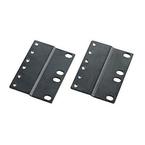Part Datasheet Search > Infineon > PEB20532 Datasheet PDF
PEB20532 Datasheet PDF
ADatasheet has not yet included the datasheet for PEB20532
If necessary, please send a supplementary document request to the administrator

PEB20532 Datasheet PDF (282 Pages)
PEB20532 Specifications
| TYPE | DESCRIPTION |
|---|---|
| Mounting Style | Surface Mount |
| Number of Pins | 100 Pin |
| Case/Package | LFQFP |
PEB20532 Size & Package
| TYPE | DESCRIPTION |
|---|---|
| Product Lifecycle Status | Unknown |
| Size-Length | 14 mm |
| Size-Width | 14 mm |
PEB20532 Environmental
PEB20532 Function Overview
Introduction
●The SEROCCO-M is a Serial Communication Controller with two independent serial channels1). The serial channels are derived from updated protocol logic of the ESCC and DSCC4 device family providing a large set of protocol support and variety in serial interface configuration. This allows easy integration to different environments and applications.
●Features
●Serial communication controllers (SCCs)
●• Two independent channels
●• Full duplex data rates on each channel of up to 16 Mbit/s sync - 2 Mbit/s with DPLL
●• 64 Bytes deep receive FIFO per SCC
●• 64 Bytes deep transmit FIFO per SCC
●Serial Interface
●• On-chip clock generation or external clock sources
●• On-chip DPLLs for clock recovery
●• Baud rate generator
●• Clock gating signals
●• Clock gapping capability
●• Programmable time-slot capability for connection to TDM interfaces (e.g. T1, E1)
●• NRZ, NRZI, FM and Manchester data encoding
●• Optional data flow control using modem control lines (RTS, CTS, CD)
●• Support of bus configuration by collision detection and resolution
●Bit Processor Functions
●• HDLC/SDLC Protocol Modes
● – Automatic flag detection and transmission
● – Shared opening and closing flag
● – Generation of interframe-time fill ’1’s or flags
● – Detection of receive line status
● – Zero bit insertion and deletion
● – CRC generation and checking (CRC-CCITT or CRC-32)
● – Transparent CRC option per channel and/or per frame
● – Programmable Preamble (8 bit) with selectable repetition rate
● – Error detection (abort, long frame, CRC error, short frames)
●• Bit Synchronous PPP Mode
● – Bit oriented transmission of HDLC frame (flag, data, CRC, flag)
● – Zero bit insertion/deletion
●– 15 consecutive ’1’ bits abort sequence
●• Octet Synchronous PPP Mode
● – Octet oriented transmission of HDLC frame (flag, data, CRC, flag)
● – Programmable character map of 32 hard-wired characters (00H-1FH)
● – Four programmable characters for additional mapping
● – Insertion/deletion of control-escape character (7DH) for mapped characters
●• Asynchronous PPP Mode
● – Character oriented transmission of HDLC frame (flag, data, CRC, flag)
● – Start/stop bit framing of single character
● – Programmable character map of 32 hard-wired characters (00H-1FH)
● – Four programmable characters for additional mapping
● – Insertion/deletion of control-escape character (7DH) for mapped characters
●• Asynchronous (ASYNC) Protocol Mode
● – Selectable character length (5 to 8 bits)
● – Even, odd, forced or no parity generation/checking
● – 1 or 2 stop bits
● – Break detection/generation
● – In-band flow control by XON/XOFF
● – Immediate character insertion
● – Termination character detection for end of block identification
● – Time out detection
● – Error detection (parity error, framing error)
●• BISYNC Protocol Mode
● – Programmable 6/8 bit SYN pattern (MONOSYNC)
● – Programmable 12/16 bit SYN pattern (BISYNC)
● – Selectable character length (5 to 8 bits)
● – Even, odd, forced or no parity generation/checking
● – Generation of interframe-time fill ’1’s or SYN characters
● – CRC generation (CRC-16 or CRC-CCITT)
● – Transparent CRC option per channel and/or per frame
● – Programmable Preamble (8 bit) with selectable repetition rate
● – Termination character detection for end of block identification
● – Error detection (parity error, framing error)
●• Extended Transparent Mode
● – Fully bit transparent (no framing, no bit manipulation)
● – Octet-aligned transmission and reception
●• Protocol and Mode Independent
● – Data bit inversion
● – Data overflow and underrun detection
● – Timer
●Protocol Support
●• Address Recognition Modes
● – No address recognition (Address Mode 0)
● – 8-bit (high byte) address recognition (Address Mode 1)
● – 8-bit (low byte) or 16-bit (high and low byte) address recognition (Address Mode 2)
●• HDLC Automode
● – 8-bit or 16-bit address generation/recognition
● – Support of LAPB/LAPD
● – Automatic handling of S- and I-frames
● – Automatic processing of control byte(s)
● – Modulo-8 or modulo-128 operation
● – Programmable time-out and retry conditions
● – SDLC Normal Response Mode (NRM) operation for slave
●• Signaling System #7 (SS7) support
● – Detection of FISUs, MSUs and LSSUs
● – Unchanged Fill-In Signaling Units (FISUs) not forwarded
● – Automatic generation of FISUs in transmit direction (incl. sequence number)
● – Counting of errored signaling units
●• Optional DTACK/READY controlled cycles
●Microprocessor Interface
●• 8/16-bit bus interface
●• Multiplexed and De-multiplexed address/data bus
●• Intel/Motorola style
●• Asynchronous interface
●• Maskable interrupts for each channel
show more
PEB20532 Documents
Part Datasheet PDF Search
Example: STM32F103
72,405,303 Parts Datasheet PDF, Update more than 5,000 PDF files ervery day.

